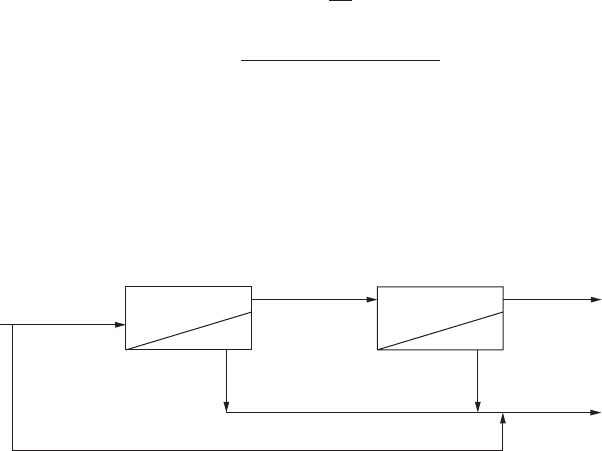Lin S.D. Water and Wastewater Calculations Manual
Подождите немного. Документ загружается.


Step 4. Estimate blended flows
Using C
p
⫽ 0.367 kg/m
3
, estimate TDS concentration of the product water.
The TDS in the blended water is limited to 0.45 kg/m
3
.
Mass balance equation would be
(Q
f
⫹ Q
p
) (0.45 kg/m
3
) ⫽ Q
f
(2.6 kg/m
3
) ⫹ Q
p
(0.367 kg/m
3
)
2.15Q
f
⫺ 0.083Q
p
⫽ 0 (1)
and
Q
f
⫹ Q
p
⫽ 0.25 m
3
/s
Q
p
⫽ 0.25 ⫺ Q
f
(2)
Substituting (2) into (1)
2.15Q
f
⫺ 0.083 (0.25 ⫺ Q
f
) ⫽ 0
2.067Q
f
⫽ 0.02075
Q
f
⫽ 0.010 (m
3
/s)
then Q
p
⫽ (0.25 ⫺ 0.01) m
3
/s ⫽ 0.24 m
3
/s
The water supply will use blending 0.24 m
3
/s of RO product water and 0.01 m
3
/s
of feedwater (4%).
Step 5. Compute the required membrane area
Example 5: Determine the sizes of a 4 MGD (15,140 m
3
/d) RO system to pro-
duce a final blended water TDS of <300 mg/L. The design average TDS in feed-
water is 1100 mg/L. The other design criteria (Crittenden et al., 2005) and
conditions are given below:
5 32,880 m
2
5
0.24 m
3
/s 3 1000 kg/m
3
7.3 3 10
23
kg/m
2
#
s
A 5
Q
p
f
w
Public Water Supply 455
Stage 1 Stage 2
2400 m
3
/d
480 m
3
/d
12,000 m
3
/d
9600 m
3
/d 1920 m
3
/d
Bypass 3100 m
3
/d
14,620 m
3
/d
Plant average flow rate, Q 15,100 m
3
/d
Feedwater pressure 1035 kN/m
2
(150 psi, 10.3 bar)
Feedwater temperature 20ºC
System recovery factor, R 80% for both stages 1and 2
Salt rejection, Rej 96%
System design criteria
Number of RO skids 3
Capacity per skid 5040 m
3
/d
Membrane area per element 32.5 m
2
Element per pressure vessel 7 maximum
Number of stages per skid 2
Average permeate flux for stage 1 22 L/m
2
⋅ h
Average permeate flux for stage 2 17 L/m
2
⋅ h
solution:
Step1. Calculate expected permeate TDS concentration in stage 1, C
p1
, using
Eq. (5.194b)
Step 2. For stage 1 per skid: Calculate permeate flow rate (Q
p1
), concentrate
flow rate Q
c
, and TDS in concentrate C
c
(by mass balance)
Q
p1
⫽ QR ⫽ 5040 m
3
/d ⫻ 0.80 ⫽ 4030 m
3
/d
Q
c1
⫽ 5040 m
3
/d ⫺ 4030 m
3
/d ⫽ 1010 m
3
/d
then 1010 m
3
/d ⫻ C
c
⫹ 4030 m
3
/d ⫻ 55 mg/L ⫽ 5040 m
3
/d ⫻ 1100 mg/L
C
c
⫽ (5040 ⫻ 1100⫺4030 ⫻ 55)/1010
⫽ 5270 (mg/L)
Step 3. For stage 2 per skid: Same as Steps 1 and 2, but using feedwater
flow rate of 1010 m
3
/d and TDS of 5270 mg/L (which is actual feed to second
stage), we calculate TDS concentration and flow rate, for both permeate (C
p2
and Q
p2
) and concentrate (C
c2
and Q
c2
) for the stage 2
C
p2
⫽ 5270 mg/L ⫻ 0.04/0.8 ⫽ 264 mg/L
Q
p2
⫽ 1010 m
3
/d ⫻ 0.8 ⫽ 808 m
3
/d (say 810 m
3
/d )
Q
c2
⫽ 1010 m
3
/d ⫺ 810 m
3
/d ⫽ 200 m
3
/d
and 200 m
3
/d ⫻ C
c2
⫹ 810 m
3
/d ⫻ 264 mg/L ⫽ 1010 m
3
/d ⫻ 5270 mg/L
C
c2
⫽ 25,540 mg/L
Step 4. Compute combined permeate flow rate Q
p
, and its TDS concentra-
tion C
p
Q
p
⫽ Q
p1
⫹ Q
p2
⫽ 4030 m
3
/d ⫹ 810 m
3
/d ⫽ 4840 m
3
/d
5 55 mg/L
C
p1
5 C
f
s1–Rejd/R 5 1100 mg/L s1–0.96d/0.80
456 Chapter 5
and Q
p
C
p
⫽ Q
p1
C
p1
⫹ Q
p2
C
p2
4840 m
3
/d ⫻ C
p
⫽ 4030 m
3
/d ⫻ 55 mg/L ⫹ 810 m
3
/d ⫻ 264 mg/L
C
p
⫽ 90 mg /L
Step 5. Determine the fraction (F) of the plant flow rate for bypass flow Q
b
from feedwater to blend with the final permeate and to meet finished water
TDS <300 mg/L requirement (same Q
final
)
F ⫻ 1100 mg /L ⫹ (1⫺ F) ⫻ 90 mg/L ⫽ 1 ⫻ 300 mg/L
F ⫽ 0.208
Q
b
⫽ 0.208 ⫻ 5040 m
3
/d ⫽ 1050 m
3
/d
Step 6. Compute feedwater flow rate to be treated (Q
t
) by RO system to
meet the TDS <300 mg/L requirement
Q
t
⫽ 5040 m
3
/d ⫺ 1050 m
3
/d ⫽ 3990 m
3
/d (say 4000 m
3
/d )
Step 7. Determine RO system per skid
Feedwater flow rate ⫽ 4000 m
3
/d
Permeate flow rate ⫽ 3200 m
3
/d
Concentrate flow rate ⫽ 800 m
3
/d
System recovery ⫽ 80%
Number of RO skids ⫽ 3
Permeate capacity per skid ⫽ 3200 m
3
/d
Step 8. Sizing RO for stage 1 per skid
Capacity per skid ⫽ 4000 m
3
/d ⫽ 4000 m
3
/d ⫻ 1000 L/m
3
÷ 24 h/d
⫽ 167,000 L/h
Permeate flow for each element ⫽ 32.5 m
2
⫻ 22 L/m
2
⋅ h ⫽ 715 L/h
Number of elements ⫽ (167,000 L/h) / (715 L/h) ⫽ 237
Provide 240 elements. Using 6 elements per pressure vessel, 40 pressure ves-
sels are needed.
Step 9. Sizing RO for stage 2 per skid
Capacity per array ⫽ 4000 m
3
/d ⫻ 0.2 ⫽ 800 m
3
/d ⫻ 1000 L/m
3
÷ 24 h/d
⫽ 33,300 L/h
Flux rate for each element ⫽ 32.5 m
2
⫻ 17 L/m
2
⋅ h ⫽ 552.5 L/h
Number of elements ⫽ (33,300 L/h)/(552.5 L/h) ⫽ 60
Public Water Supply 457

Provide 60 elements. There will be 10 pressure vessels that use 6 elements
per pressure vessel.
16.4 Silt density index
Silt density index (SDI) test involves water filtering in the dead end
mode with no cross-flow at a constant pressure of 207 kPa (30 psig). It
uses disc membranes rated at 0.45 m for a 15-min test with a 500-mL
water sample. The SDI is calculated as (Chellam et al., 1997):
(6.150)
where SDI ⫽ silt density index
t
i
⫽ time initially needed to filter 500 mL of sample
t
f
⫽ time needed to filter 500 mL at the end of the 15-min
test period
The SDI has been widely used as a rough estimation of the potential
for colloidal fouling of NF and RO systems. Generally, the feedwaters
for NF and RO should have SDI of 4 or less. (Most manufacturers have
a 4 as warranty limit.)
Example: The time initially required to filter 500 mL of dual-media filter
effluent is 14.5 s. The time required to filter 500 mL of the same water sample
at the end of the 15-min test period is 35 s. Calculate the SDI.
solution:
17 Residual from Water Plant
A water treatment plant not only produces drinking water, but is also
a solids generator. The residual (solids or wastes) comes principally
from clarifier basins and filter backwashes. These residuals contain
solids which are derived from suspended and dissolved solids in the
raw water with the addition of chemicals and chemical reactions.
Depending on the treatment process employed, waste from water
treatment plants can be classified as alum, iron, or polymer sludge from
coagulation and sedimentation; lime sludge or brine waste from water
5 3.9
SDI 5 a1 2
t
i
t
f
b
100
15
5 a1 2
14.5 s
35 s
b 3
100
15
SDI 5 a1 2
t
i
t
f
b
100
15
458 Chapter 5
softening; backwash wastewater and spent granular activated carbon
from filtration; and wastes from iron and manganese removal process,
ion exchange process, diatomaceous earth filters, microstrainers, and
membranes.
The residual characteristics and management of water plant sludge
and environmental impacts are discussed in detail elsewhere (Lin and
Green, 1987).
Prior to the 1970s, residuals from a water treatment plant were dis-
posed of in a convenient place, mostly in surface water. Under the 1972
Water Pollution Control Act, the discharge of a water plant residuals
requires a National Pollution Discharge Elimination System (NPDES)
permit. Residuals directly discharged into surface water is prohibited
by law in most states. Proper residual (solids) handling, disposal, and/or
recovery is necessary for each waterwork nowadays. Engineers must
make their best estimate of the quantity and quality of residuals gen-
erated from the treatment units.
Example 1: A conventional water treatment plant treats an average flow
of 0.22 m
3
/s (5.0 MGD). The total suspended solids (TSS) concentration in
raw (river) water averages 88 mg/L. The TSS removal through sedimenta-
tion and filtration processes is 97%. Alum is used for coagulation/sedimen-
tation purpose. The average dosage of alum is 26 mg/L. Assume the
aluminum ion is completely converted to aluminum hydroxide, (a) Compute
the average production of alum sludge. (MW: Al ⫽ 27, S ⫽ 32, O ⫽ 16, and
H ⫽ 1). (b) Estimate the volume of residual produced daily, assuming the
specific gravity of 4.0% solids is 1.02.
solution:
Step 1. Determine quantity (q
1
) settled for TSS
TSS ⫽ 88 mg/L ⫽ 88 g/m
3
q
l
⫽ flow ⫻ TSS ⫻ % removal
⫽ 0.22 m
3
/s ⫻ 88 g/m
3
⫻ 0.97
⫽ 18.8 g/s
Step 2. Determine A1(OH)
3
generated, q
2
The reaction formula for alum and natural alkalinity in water using Eg. (5.51a):
A1
2
(SO
4
)
3
⋅ 18H
2
O ⫹ 3Ca(HCO
3
)
2
→ 2A1(OH)
3
⫹ 3CaSO
4
⫹ 6CO
2
⫹ 18H
2
O
27 ⫻ 2 ⫹ 3(32 ⫹ 16 ⫻ 4) ⫹ 18(18) 2(27 ⫹ 17 ⫻ 3)
⫽ 666 ⫽ 156
The above reaction formula suggests that each mole of dissolved Al
3⫹
dosed
will generate 2 moles of A1(OH)
3
Public Water Supply 459

Step 3. Compute total residual generated q for (a)
or
or
Step 4. Compute the volume generated daily for (b)
Volume ⫽ 1740 kg/d ÷ (1000 kg/m
3
⫻ 1.02 ⫻ 0.04)
⫽ 42.6 m
3
/d
or Volume ⫽ 3818 lb/d ÷ (62.4 lb/ft
3
⫻ 1.02 ⫻ 0.04)
⫽ 1500 ft
3
/d
Example 2: A river raw water is coagulated with a dosage of 24 mg/L of fer-
rous sulfate and an equivalent dosage of 24 mg/L of ferrous sulfate and an equiv-
alent dosage of lime. Determine the sludge generated per m
3
of water treated.
solution: From Eqs. (5.51 f) and (5.51 g), 1 mole of ferrous sulfate reacts with
1 mole of hydrated lime and this produces 1 mole of Fe(OH)
3
precipitate.
MW of FeSO
4
⋅ 7H
2
O ⫽ 55.85 ⫹ 32 ⫹ 4 ⫻ 16 ⫹ 7 ⫻ 18
⫽ 277.85
MW of Fe(OH)
3
⫽ 55.85 ⫹ 3 ⫻ 17
⫽ 106.85
By proportion
sludge
F.S. dosage
5
106.85
277.85
5 0.3846
5 3817 lb/d
5 1740
kg
d
3
2.194 lb
1 kg
5 1740 kg/d
5 20.14
g
s
3
1 kg
1000 g
3
86,400 s
1 day
5 20.14 g/s
q 5 q
1
1 q
2
5 18.8 g/s 1 1.34 g/s
5 1.34 g/s
5 26 g/m
3
3 0.22 m
3
/s 3
156
666
q
2
5 alum dosage 3 flow 3 c
156 g AlsOHd
3
666 g alum
d
460 Chapter 5

or
Note: Mgal ⫽ million gallons.
Example 3: A 2-MGD (0.088 m
3
/s) water system generates 220 lb/Mgal
(26.4 mg/L) solids in dry weight basis. The residual solids concentration by
weight is 0.48%. Estimate the rate of residual solids production and pump-
ing rate if the settled residual is withdrawn every 5 min/h.
solution:
Step 1. Calculate residual production
Step 2. Calculate pump capacity required
7.63 gpm ⫻ 60/5 ⫽ 92 gpm
17.1 Residual production and density
The quantity of residuals (called sludge) generated from clarifiers are
related to coagulants used, raw water quality, and process design. The
residual production for whole water plant as the weight per unit volume
treated (g/m
3
or lb/Mgal) and its solids concentration should be deter-
mined. These values with the average flow rate will be used for the esti-
mation of daily residual production. Then the residual production rate
can be employed for the design of residual (sludge) treatment units,
commonly intermitted sand drying bed. The density of residuals (pounds
per gallon) can be estimated using the following equation:
(5.151a)w 5
8.34
C
s
/r
s
1 c/r
sUS customary unitsd
s220 lb/Mgalds2 MGDd
s8.34 lb/galds0.0048d
5 10,990 gpd 5 7.63 gpm
5 77.0 lb/Mgal
5 9.23
g
m
3
3
0.0022 lb
1 g
3
1 m
3
2.642 3 10
24
Mgal
5 9.23 g/m
3
5 9.23
mg
L
3
1g
1000 mg
3
1000 L
1m
3
5 9.23 mg/L
5 24 mg/L 3 0.3846
Sludge 5 F.S. dosage 3 0.3846
Public Water Supply 461

(5.151b)
where w ⫽ density of residuals, lb/gal or kg/L
c
s
⫽ weight fractional percent of solids
c ⫽ weight fractional percent of water
s
⫽ specific gravity of solid
⫽ specific gravity of water (approximately 1.0)
Example 1: Calculate the sludge density (lb/gal) for a 6% sludge composed
of solids with a specific gravity of 2.48.
solution:
Step 1. Find specific gravity of 6% residual (sludge)
r
Weight fraction of sludge, solids, and water are 1.0, 0.06, and 0.94, respectively.
Using mass balance, we obtain
Step 2. Determine the density of the residue
or
Note: This solution is a kind of proof of Eq. (5.151).
Example 2: A water plant treats 4.0 MGD (0.175m
3
/s) and generates 240 lb
of residuals per million gallons (Mgal) treated (28.8 g/m
3
). The solid concen-
tration of the residuals is 0.5%. Estimate: (a) the daily production of residu-
als, (b) the pump capacity, if the pump operates for 12 min each hour, and (c)
the density of the residuals, assuming the specific density of the residual is
2.0 with 4% solids.
solution:
Step 1. Determine residual production rate q
(a)
5 16.0 gpm
5 23,020 gpd
q 5
s4 MGDds240 lb/Mgald
s0.005ds8.34 lb/gald
5 1037 g/L
5 8.65 lb/gal
Density 5 r
r
3 8.34 lb/gal 5 1.037 3 8.34 lb/gal
r
r
5 1.037
1
r
r
5
0.06
r
s
1
0.94
r
5
0.06
2.48
1
0.94
1.0
w 5
1
c
s
/r
s
1 c/r
sSI unitsd
462 Chapter 5

Step 2. Find pump capacity q
p
(b)
Step 3. Estimate residual density w, using Eq. (5.151)
(c)
Example 3: In a 1 MGD (0.0438 m
3
/s) waterworks, 1500 lb of dry solids
are generated per million gallons of water treated. The sludge is concen-
trated to 3% and then applied to an intermittent sand drying bed at a 18-in
depth, with 24 beds used per year. Determine the surface area needed for
the sand drying bed.
solution:
Step 1. Calculate yearly 3% sludge volume, v
v ⫽ 1500 lb/Mgal ⫻ 1 Mgal/d/0.03
⫽ 50,000 lb/d
⫽ 50,000 lb/d ⫻ 365 d/(62.41b/ft
3
)
⫽ 292,500 ft
3
⫽ 8,284 m
3
Step 2. Calculate area A (D ⫽ depth, n ⫽ number of applications/year)
v ⫽ ADn
or A ⫽ v/Dn ⫽ 292,500 ft
3
/(1.5 ft ⫻ 24)
⫽ 8125 ft
2
⫽ 755 m
2
18 Disinfection
Disinfection is a process to destroy disease-causing organisms, or
pathogens. Disinfection of water can be done by boiling the water,
ultraviolet radiation, and chemical inactivation of the pathogen. In the
water treatment processes, pathogens and other organisms can be
partly physically eliminated through coagulation, flocculation, sedi-
mentation, and filtration, in addition to the natural die-off. After fil-
tration, to ensure pathogen-free water, the chemical addition of
5 8.51 lb/gal
w 5
8.34
0.04/2.0 1 0.96/1.0
5 80 gpm
q
p
5 16 gpm 3
60 min
12 min
Public Water Supply 463

chlorine (so called chlorination), rightly or wrongly, is most widely used
for disinfection of drinking water. This less expensive and powerful dis-
infection of drinking water provides more benefits than its short coming
due to disinfection by-products (DBPs). DBPs have to be controlled. The
use of ozone and ultraviolet for disinfection of water and wastewater
is increasing in the United States.
Chlorination serves not only for disinfection, but as an oxidant for
other substances (iron, manganese, cyanide, etc.) and for taste and odor
control in water and wastewater. Other chemical disinfectants include
chlorine dioxide, ozone, bromine, and iodine. The last two chemicals are
generally used for personal application, not for the public water supply.
18.1 Chemistry of chlorination
Free available chlorine. Effective chlorine disinfection depends upon its
chemical form in water. The influencing factors are temperature, pH, and
organic content in the water. When chlorine gas is dissolved in water,
it rapidly hydrolyzes to hydrochloric acid (HCl) and hypochlorous
acid (HOCl)
Cl
2
⫹ H
2
O ↔ H
⫹
⫹ Cl
⫺
⫹ HOCl (5.152)
The equilibrium constant is
(5.153)
The dissolution of gaseous chlorine, Cl
2(g)
, to form dissolved molecu-
lar chlorine, Cl
2(aq)
follows Henry’s law and can be expressed as (Downs
and Adams, 1973)
(5.154)
where [Cl
2(aq)
] ⫽ molar concentration of Cl
2
P
Cl
2
⫽ partial pressure of chlorine in atmosphere
The distribution of free chlorine between HOCl and OCl
⫺
is presented
in Fig. 5.10. The disinfection capabilities of HOCl is generally higher
than that of OCl
⫺
(Water, 1978).
(5.155) 5 4.805 3 10
26
expa
2818.48
T
b
H 5 Henry’s law constant, mol/L atm
Cl
2sgd
5
Cl
2saqd
Hsmol/L atmd
5
[Cl
2saqd
]
P
Cl
2
5 4.48 3 10
24
at 258C sWhite, 1972d
K
H
5
[H
1
][Cl
2
][HOCl]
[Cl
2saqd
]
464 Chapter 5
